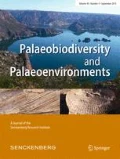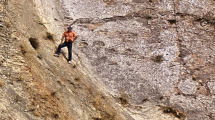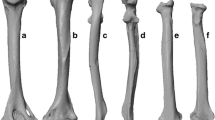Abstract
Eocene mammals from Grube Messel are divided into those that lived terrestrially on the ground (2D-mammals) or arboreally (3D-mammals). Their biomechanics and locomotion are discussed on the basis of equids (Eurohippus, Propalaeotherium) and Leptictidium as examples of 2D-mammals and primates (Europolemur, Darwinius) of 3D-mammals. The determining factor for lifestyle is the autopodia: 2D-mammals need nothing more than compression-transmitting balls with reinforced anterior margins (hooves). These autopodia do not require much energy, but metapodia and even phalanges can elongate the functional length of the free limbs. Primates as 3D-animals need prehensile hands and feet, which can transmit tensile forces and even torques. Their metapodials are part of the prehensile organ. Their strong and energy-requiring musculature increases the masses on the distal limb segments and so influences the locomotor modes.












Similar content being viewed by others
References
Arms A, Voges D, Preuschoft H, Fischer M (2002) Arboreal locomotion in small new-world monkeys. In: Okada M, Preuschoft H (eds) Arboreal locomotor adaptation in primates and its relevance to human evolution. Z Morphol Anthropol, Sonderh 83(2/3):243–263
Buck C, Bär H (1993) Investigations on the biomechanical significance of dermatoglyphic ridges. In: Preuschoft H, Chivers DJ (eds) Hands of primates. Springer, New York, pp 285–306
Camp CL, Smith N (1942) Phylogeny and functions of the digital ligaments of the horse. Mem Univ Calif 13:69–122
Cartmill M (1974) Pads and claws in arboreal locomotion. In: Jenkins P (ed) Primate locomotion. Academic Press, New York, pp 45–83
Cartmill M (1985) Climbing. In: Hildebrand et al (eds) Functional vertebrate morphology. Harvard University Press, Cambridge, pp 73–88
Christian A (1995) Zur Biomechanik der Lokomotion vierfüßiger Reptilien. Cour Forsch-Inst Senckenberg 180:1–58
Christian A (1999) Zur Biomechanik der Fortbewegung von Leptictidium (Mammalia, Proteutheria). Cour Forsch-Inst Senckenberg 216:1–18
Christian A, Horn HG, Preuschoft H (1994a) Bipedie bei rezenten Reptilien. Natur und Museum 124:45–57
Christian A, Horn HG, Preuschoft H (1994b) Biomechanical reasons for bipedalism in reptiles. Amphibia-Reptilia 15:275–284
Demes B, Günther MM (1989a) Wie die Körpermasse den Springstil von Halbaffen und deren Proportionen bestimmt. Z Morphol Anthropol 77:209–225
Demes B, Günther MM (1989b) Biomechanics and allometric scaling in primate locomotion and morphology. Folia Primatol 53:125–141
Dubbel H (1981) Taschenbuch des Maschinenbaus. Springer, Berlin
Fischer M (1994) Crouched posture and high fulcrum, a principle of locomotion in small mammals. J Hum Evol 26:501–521
Fischer MS, Lilje KE (2011) Hunde in Bewegung. Franckh-Kosmos, Stuttgart
Fischer M, Krause C, Lilje KE (2010) Evolution of chamaeleon locomotion, or how to become arboreal if being a reptile. Zoology 113(2):67–74
Franzen JL (1987) Ein neuer Primate aus dem Mitteleozän der Grube Messel (Deutschland, S-Hessen). Cour Forsch-Inst Senckenberg 91:151–187
Franzen JL (1988) Ein weiterer Primatenfund aus der Grube Messel bei Darmstadt. Cour Forsch-Inst Senckenberg 107:275–289
Franzen JL (2000) Europolemur kelleri n. sp. von Messel und ein Nachtrag zu Europolemur koenigswaldi (Mammalia, Primates, Notharctidae, Cercamoniinae). Senck leth 80:275–287
Franzen JL (2007) Eozäne Equoidea (Mammalia, Perissodactyla) aus der Grube Messel bei Darmstadt (Deutschland). Funde der Jahre 1969–2000. Schweiz Paläontol Abh 127:1–245
Franzen JL (2010) Darwinius masillae – Darwins Halbaffe und die Primatenfunde aus der Grube Messel. Natur und Museum 140(1/2):12–29
Franzen JL (2011) Strepsirrhine or haplorhine? In: Lehmann T, Schaal SFK (eds) The world at the time of Messel: puzzles in palaeobiology, palaeoenvironment and the history of early primates. (22nd Int Senckenberg Conf, conference volume). Senckenberg Gesellschaft für Naturforschung, Frankfurt am Main, pp 59–60
Franzen JL, Frey E (1993) Europolemur completed. Kaupia-Darmstädter Beitr Naturgesch 3:113–130
Franzen JL, Gingerich PD, Habersetzer J, Hurum JH, Koenigswald W, Smith H (2009) Complete primate skeleton from the Middle Eocene of Messel in Germany: Morphology and Paleobiology. PLoS One 4(5):1–27. doi:10.1371/journal.pone.0005723, e5723
Godinot M, Beard KC (1993) A survey of fossil primate hands. In: Preuschoft H, Chivers DJ (eds) Hands of primates. Fischer, Wien, pp 335–378
Günther MM (1989) Funktionsmorphologische Untersuchungen zum Sprungverhalten mehrerer Halbaffen. Dissertation, FU Berlin
Günther MM, Preuschoft H, Ishida H, Nakano Y (1992) Can prosimian-like leaping be considered a preadaptation to bipedal walking in hominids? In: Matano S, Tuttle RH, Ishida H, Goodman M (eds) Topics in primatology, 3 Evolutionary biology, reproductive endocrinology and virology. University of Tokyo Press, Tokyo, pp 153–165
Herkner B (1989) Die Entwicklung der saltatorischen Bipedie bei Säugetieren innerhalb der Tetrapoden-Evolution. Cour Forsch-Inst Senckenberg 111:1–102
Ishida H, Jouffroy FK, Nakano Y (1990) Comparative dynamics of pronograde and upside-down horizontal quadrupedalism in the slow loris (Nycticebus coucang). In: Jouffroy FK, Stack HH, Niemitz C (eds) Gravity, posture and locomotion in primates. Il Sedicesimo, Firenze, pp 209–220
Jouffroy FK, Lessertisseur J (1979) Relationships between limb morphology and locomotor adaptations among prosimians: an osteometric study. In: Morbeck ME, Preuschoft H, Gomberg N (eds) Environment, behavior and morphology: dynamic interactions in primates. G. Fischer, New York, pp 143–181
Jouffroy FK, Stern JT (1990) Telemetered EMG-study of the antigravity versus propulsive actions of the knee and elbow muscles in the slow loris (Nycticebus coucang). In: Jouffroy FK, Stack HH, Niemitz C (eds) Gravity, posture and locomotion in primates. Il Sedicesimo Firenze, pp 221–236
Jouffroy FK, Godinot M, Nakano Y (1993) Biometrical characteristics of primate hands. In: Preuschoft H, Chivers DJ (eds) Hands of primates. Springer, New York, pp 133–172
Koenigswald Wv, Habersetzer J, Gingerich PD (2011) Morphology and evolution of the distal phalanges in primates. In: Lehmann T, Schaal SFK (eds) The world at the time of Messel: puzzles in palaeobiology, palaeoenvironment and the history of early primates. (22nd Int Senckenberg Conf, conference volume). Senckenberg Gesellschaft für Naturforschung, Frankfurt am Main, pp 91–94
Kümmell S (2009) Die Digiti der Synapsida: Anatomie, evolution und Konstruktionsmorphologie. Shaker, Aachen, p 424
Kummer B (1959) Bauprinzipien des Säugerskeletes. Thieme, Stuttgart
Kummer B (1960) Biomechanik des Säugerskelettes. In: Helmke JG, Lengerken H, Starck D (eds) Handbuch der Zoologie. Walter de Gruyter, Berlin, p 80 and following, 8, 6(2)
Leakey MD (1987) Introduction to the hominid footprints. In: Leakey MD, Harris JM (eds) Laetoli: a Pleistocene site in northern Tansania. Clarendon Press, Oxford, pp 490–496
Lehmann T (1974/1977) Elemente der Mechanik, 3 Bde., Braunschweig (Vieweg)
Mollison T (1911) Die Körperproportionen der Primaten. Gegenbauers Morphol Jahrb 42:79–304
Morbeck ME (1979) Forelimb use and positional adaptation in Colobus guereza: integration of behavioural, ecological and anatomical data. In: Morbeck ME, Preuschoft H, Gomberg N (eds) Environment, behavior and morphology: dynamic interactions in primates. G. Fischer, New York, pp 95–117
Nakano Y (1998) Footfall patterns in the early development of quadrupedal walking of Japanese macaques. In: Kimura T, Preuschoft H, Rose MD (eds) Development and control in primate locomotion. Folia Primatol spec iss 66:126–136
Nakano Y (2002) The effects of substratum inclination on locomotor patterns in primates. In: Okada M, Preuschoft H (eds) Arboreal locomotor adaptation in primates and its relevance to human evolution. Z Morphol Anthropol, Sonderh 83:189–199
Nieschalk U (1991) Fortbewegung und Funktionsmorphologie von Loris tardigradus und anderen kleinen quadrupeden Halbaffen in Anpassung an unterschiedliche Habitate. Naturwiss Diss, Bochum
Nieschalk U, Demes B (1993) Biomechanical determinants of reduction of the second ray in Lorisinae. In: Preuschoft H, Chivers DJ (eds) Hands of primates. Springer, New York, pp 225–234
Owen-Smith R (1988) Megaherbivores: the influence of very large body size on ecology. Cambridge University Press, Cambridge
Patel BA, Seiffert ER, Boyer DM (2011) Origin and early evolution of the grasping big toe in primates: new fossils and key characters evaluated within a phylogenetic context. In: Lehmann T, Schaal SFK (eds) The world at the time of Messel: puzzles in palaeobiology, palaeoenvironment and the history of early primates. (22nd Int Senckenberg Conf, conference volume). Senckenberg Gesellschaft für Naturforschung, Frankfurt am Main, pp 127–128
Pauwels F (1965) Gesammelte Abhandlungen zur Funktionellen Anatomie des Bewegunsapparates. Springer, Berlin
Peters A, Preuschoft H (1984) External biomechanics of leaping in Tarsius and its morphological and kinematic consequences. In: Niemitz C (ed) Biology of tarsiers. G. Fischer, Stuttgart, pp 227–256
Peters DS, Gutmann WF (1971) Über die Lesrichtung von Merkmals- und Konstruktionsreihen. Z zool Syst Evolutionsforsch 9:237–263
Pflughöft G (1990) Untersuchungen zum Verhalten von Lemur fulvus E. Geoffroy, 1796 und Lemur catta Linnaeus, 1758 in zoologischen Gärten unter besonderer Berücksichtigung der Positions- und Lokomotionsweisen sowie der Substratnutzung. Dissertation Berlin
Preuschoft H (1961) Muskeln und Gelenke der Hinterextremität des Gorilla. Morphol Jahrb 101:432–540
Preuschoft H (1963) Beitrag zu Funktion des Pongidenfußes. Z Morphol Anthropol 53:19–28
Preuschoft H (1969) Statische Untersuchungen am Fuß der Primaten. I. Phalangen und Metatarsalia. Z Anat Entwicklungsgesch 129:285–345
Preuschoft H (1970) Functional anatomy of the lower extremity. In: Bourne GH (ed) The chimpanzee, vol 3. Karger, Basel, pp 221–294
Preuschoft H (1971) Body posture and mode of locomotion in early Pleistocene hominids. Folia Primatol 14:209–240
Preuschoft H (1973a) Functional anatomy of the upper extremity. In: Bourne GH (ed) The chimpanzee, vol 6. Karger, pp 34–120
Preuschoft H (1973b) Body posture and locomotion in some East African Miocene Dryopithecinae. In: Day MH (ed) Human evolution, 11th edn. Taylor & Francis, London, pp 13–46
Preuschoft H (1975) Body posture and mode of locomotion in fossil primates - method and example: Aegyptopithecus zeuxis. Symposium, 5th Congress of the International Primatological Society. Nagoya 1974, Japan Science Press, Tokyo, 345–359
Preuschoft H (2002) What does “arboreal locomotion” mean exactly and what are the relationships between “climbing”, environment and morphology? Z Morphol Anthropol 83:171–188
Preuschoft H (2004a) Die Biomechanik des aufrechten Gangs und deren Konsequenzen für die Evolution des Menschen. Conard NJ (ed) Ringvorlesung “Woher kommt der Mensch?” Attempto, Tübingen, pp 32–68
Preuschoft H (2004b) Mechanisms for the acquisition of habitual bipedality: are there biomechanical reasons for the acquisition of upright bipedal posture? J Anat 204:363–384
Preuschoft H, Demes B (1984) Biomechanics of brachiation. In: Preuschoft H, Brockelman WY, Chivers DJ, Creel N (eds) The lesser apes. Evolutionary and behavioral biology. Edinburgh University Press, Edinburgh, pp 96–118
Preuschoft H, Demes B (1985) Influence of size and proportions on biomechanics of brachiation. In: Jungers WL (ed) Size and scaling in primate biology. Plenum Press, New York, pp 383–398
Preuschoft H, Günther MM (1994) Biomechanics and body shape in primates compared with horses. Z Morphol Anthropol 80:149–165
Preuschoft H, Witte H, Demes B (1992) Biomechanical factors that influence overall body shape of large apes and humans. In: Matanao S, Tuttle R, Ishida H, Goodman M (eds) Topics in primatology, evolutionary biology, vol 3. University of Tokyo Press, Tokyo, pp 259–289
Preuschoft H, Godinot M, Beard C, Nieschalk U, Jouffroy FK (1993) Biomechanical considerations to explain important morphological characters of primate hands. In: Preuschoft H, Chivers DJ (eds) Hands of primates. Springer, New York, pp 246–253
Preuschoft H, Witte H, Christian A, Recknagel S (1994) Körpergestalt und Lokomotion bei grossen Säugetieren. Verh Deutsch Zool Ges 87:147–163
Preuschoft H, Witte H, Fischer M (1995) Locomotion in nocturnal primates. In: Alterman L et al (eds) Creatures of the dark: the nocturnal prosimians. Plenum Press, New York, pp 453–472
Preuschoft H, Witte H, Christian A, Fischer M (1996) Size influence on primate locomotion and body shape, with special emphasis on the locomotion of “small mammals”. Folia Primatol 66:93–112
Preuschoft H, Christian A, Günther MM (1998) Size dependences in prosimian locomotion and their implications for the distribution of body mass. Folia Primatol 69(suppl 1):60–81
Preuschoft H, Schmidt M, Hayama S, Okada M (2003) The influence of three-dimensional movements of the forelimb on the shape of the thorax and its importance for erect body posture. In: Franzen JL (ed) Walking upright. Cour Forsch-Inst Senckenberg 243:9–24
Preuschoft H, Hohn B, Stoinski S, Witzel U (2011) Why so huge? Biomechanical reasons for the acquisition of large size in sauropod and theropod dinosaurs. In: Klein NK, Remes K, Gee CT, Sander M (eds) Biology of the Sauropod dinosaurs: understanding the life of giants. Indiana University Press, Bloomington, pp 197–218
Rose MD (1979) Positional behaviour of natural populations: some quantitative results of a field study of Colobus guereza and Cercopithecus aethiops. In: Morbeck ME, Preuschoft H, Gomberg N (eds) Environment, behavior and morphology: dynamic interactions in primates. G. Fischer, New York, pp 95–117
Schilling N, Fischer MS (1999) Kinematic analysis of treadmill locomotion of Tupaia glis (Scandentia, Tupaiidae). Z Säugetierkd 64:129–153
Schmalfuss UK (1995) Kinematik und funktionelle Anatomie der Vorderextremität von Tragulus javanicus (Mammalia: Artiodactyla: Tragulidae), Diplomarbeit Biologie Tübingen
Schmidt M, Fischer M (2000) Cineradiographic study of forelimb movements during quadrupedal walking in the brown lemur (Eulemur fulvus, Primates: Lemuridae). Am J Phys Anthropol 111:245–262
Schmidt M, Voges C, Fischer M (2002) Shoulder movements during quadruped locomotion in arboreal primates. Z Morphol Anthropol 78:235–242
Schultz AH (1930) The skeleton of the trunk and limbs of higher primates. Hum Biol 2:303–438
Schultz AH (1933) Die Körperproportionen der erwachsenen catarrhinen Primaten. Anthropol Anz 10:154–185
Slijper EJ (1946) Comparative biologic-anatomical investigations on the vertebral column and spinal musculature of mammals. Verh Koningl Akad Wetensch, Afd Natuurkd (2)142:1–128
Stoinski S, Suthau T, Gunga HC (2011) Reconstructing body volume and surface area of dinosaurs using laser scanning and photogrammetry. In: Klein NK, Remes K, Gee CT, Sander M (eds) Biology of the Sauropod dinosaurs: understanding the life of giants. Indiana University Press, Bloomington, pp 94–115
Van der Sluijs L, Gerken M, Preuschoft H (2010) Comparative analysis of walking gaits in South American camelids. J Zool. doi:10.1007/s10764-010-9399-1
Vilensky JA (1983) Gait characteristics of two macaques, with emphasis on relationships with speed. Am J Phys Anthropol 61:255–265
Vilensky JA, Gankiewicz E (1989) Early development of locomotor behaviour in vervet monkeys. Am J Primatol 17:11–25
Witte H, Preuschoft H, Recknagel S (1991) Human body proportions explained on the basis of biomechanical principles. Z Morphol Anthropol 78:407–423
Witte H, Preuschoft H, Fischer MS (2002) The importance of the evolutionary heritage of locomotion on flat ground in small mammals for the development of arboreality. Z Morphol Anthropol 83:221–233
Witzel U, Preuschoft H (2008) The mechanical reasons of the internal structure of finger tips. Poster, presented at the Congress of the International Primatological Society, Edinburgh, UK
Wolff J (1892) Das Gesetz der Transformation der Knochen. Hirschwald, Berlin
Wood AR, Bebej RM, Manz CL, Begun DL, Gingerich PD (2002) Postcranial functional morphology of Hyracotherium (Equidae, Perissodactyla) and locomotion in the earliest horses. J Mamm Evol. doi:t0t007ht0914-0r0-9145-7
Acknowledgments
Our sincere thanks go to the reviewers, Prof. Dr. Ulrich Witzel (Bochum) and Prof. Dr. Andreas Christian (Flensburg), for very careful screening, ending up with precise suggestions, which have considerably improved our manuscript. We also want to thank the Deutsche Forschungsgemeinschaft. This article is publication number 127 of the Forschergruppe 533.
Author information
Authors and Affiliations
Corresponding author
Additional information
This article is a contribution to the special issue “Messel and the terrestrial Eocene - Proceedings of the 22nd Senckenberg Conference”
Rights and permissions
About this article
Cite this article
Preuschoft, H., Franzen, J.L. Locomotion and biomechanics in Eocene mammals from Messel. Palaeobio Palaeoenv 92, 459–476 (2012). https://doi.org/10.1007/s12549-012-0103-7
Received:
Revised:
Accepted:
Published:
Issue Date:
DOI: https://doi.org/10.1007/s12549-012-0103-7




